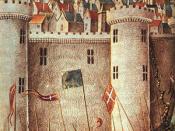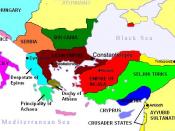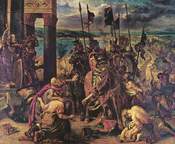The Crusades were first undertaken in 1096 and ended in the late 13th century.
The term Crusade was originally applied solely to European efforts to retake from the
Muslims the city of Jerusalem, which was sacred to Christians as the site of the crucifixion
of Jesus Christ. It was later used to designate any military effort by Europeans against
non-Christians.
The Crusaders carved out feudal states in the Near East. Thus the Crusades are an
important early part of the story of European expansion and colonialism. They mark the
first time Western Christendom undertook a military initiative far from home, the first time
significant numbers left to carry their culture and religion abroad.
In addition to the campaigns in the East, the Crusading movement includes other
wars against Muslims, pagans, and dissident Christians and the general expansion of
Christian Europe. In a broad sense the Crusades were an expression of militant
Christianity and European expansion.
They combined religious interests with secular and
military enterprises. Christians learned to live in different cultures, which they learned and
absorbed; they also imposed something of their own characteristics on these cultures. The
Crusades strongly affected the imagination and aspirations of people at the time, and to
this day they are among the most famous portions of medieval history.
After the death of Charlemagne, king of the Franks, in 814 and the collapse of his
empire, Christian Europe was under attack and on the defensive. Magyars, nomadic
people from Asia, pillaged eastern and central Europe until the 10th century. Beginning
about 800, several centuries of Viking raids disrupted life in northern Europe and even
threatened Mediterranean cities. But the greatest threat came from the forces of Islam,
militant and victorious in the centuries following the death of Muhammad in 632. By the
8th century, Islamic...



Well written
Many good facts placed nicely. Simple enough to understand, but not too simple to be bored by them.
8 out of 8 people found this comment useful.